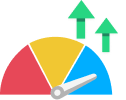High-yield savings accounts (HYSAs. What an acronym, huh?) are a solid option if you want to maximize your savings. And really, who doesn’t want to maximize their savings? These accounts offer higher returns than traditional savings accounts, and they can help your money grow faster. Here’s what to know about high-yield savings accounts:
1. Higher interest rates
The biggest advantage of high-yield savings accounts is their interest rates; they’re generally much higher than the rates you get with traditional savings accounts. A standard savings account may offer an annual percentage yield (APY) of around 0.01% to 0.05%. But a high-yield savings account can offer rates from 1% to 4%—or even higher, depending on market conditions and the financial institution.
- Real-world example: If you deposit $10,000 in a high-yield savings account with a 2% APY, you would earn $200 in interest over a year, compared to just $1 with a traditional savings account with a 0.01% APY.
2. Accessibility and convenience
Online banks, credit unions, and some traditional banks usually offer high-yield savings accounts. Online banks often provide the highest rates because they have lower overhead costs than banks that have physical locations. These types of accounts are easy to open and manage online and have features like mobile banking, electronic fund transfers, and automatic deposits.
- Tip: Look for accounts with user-friendly online platforms and mobile apps that make it easy to monitor your balance, transfer funds, and track your interest earnings.
3. FDIC or NCUA insurance
Like traditional savings accounts, high-yield savings accounts are insured by the Federal Deposit Insurance Corporation (FDIC) or the National Credit Union Administration (NCUA). That means that if the bank fails, your deposits are protected up to $250,000 (for each insured bank or credit union you have money in).
- Safety note: Always make sure that the financial institutions you’re considering are FDIC or NCUA insured to safeguard your money.
4. Potential fees and requirements
While many high-yield savings accounts come with no monthly maintenance fees or minimum balance requirements, it’s essential to read the fine print. Some accounts may impose fees for certain activities, such as excessive withdrawals or falling below a minimum balance. There also might be requirements you have to meet to get the highest advertised APY, like maintaining a certain balance or reaching a minimum number of deposits each month.
- Advice: Choose an account that aligns with your financial habits and goals. Stay away from accounts with high fees or complicated requirements that could diminish your earnings.
5. Transaction limits
High-yield savings accounts often have transaction limits due to federal regulations. Under Regulation D, savings accounts are typically limited to six “convenient” transfers or withdrawals per month. These include online transfers, automatic transfers, and payments made by check or debit card. If you exceed that limit, you might have to pay fees, or your account might even be closed.
- Pro Tip: Use your high-yield savings account mostly for saving, not frequent transactions. For everyday spending, it’s much better to use a checking account with no transaction limits.










